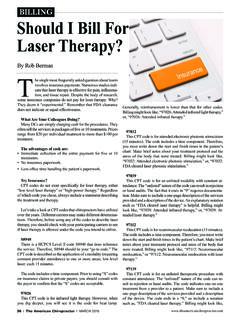Transcription of Non-Ionizing Radiations – Sources, Biological Effects ...
1 Proceedings of the International Conference on Non-Ionizing radiation at UNITEN (ICNIR2003) Electromagnetic Fields and Our Health 20th 22nd October 2003 1 Non-Ionizing Radiations Sources, Biological Effects , Emissions and Exposures Kwan-Hoong Ng Department of Radiology University of Malaya Kuala Lumpur Malaysia ABSTRACT Non-Ionizing radiation (NIR) refers to radiative energy that, instead of producing charged ions when passing through matter, has sufficient energy only for excitation. Nevertheless it is known to cause Biological Effects . The NIR spectrum is divided into two main regions, optical Radiations and electromagnetic fields.
2 The optical can be further sub-divided into ultraviolet, visible, and infra-red. The electromagnetic fields are further divided into radiofrequency (microwave, very high frequency and low frequency radio wave). Non-Ionizing radiation originates from various sources: Natural origin (such as sunlight or lightning discharges etc.) and man-made (seen in wireless communications, industrial, scientific and medical applications). The basics of Biological Effects seen with NIR relevant to human health is reviewed, including the optical Biological Effects of photochemical and heating; the electromagnetic fields of surface heating, electrical burn and shock.
3 A survey of the current emissions from various sources and exposures from human activities involving NIR based on the National Radiological Protection Board (NRPB) of the United Kingdom and the International Commission on Non-Ionizing radiation Protection (ICNIRP) is presented. Finally, a brief review of the standards and guidelines for NIR is presented. Further research based on epidemiological studies, experimental biology, volunteer studies and dosimetry are needed. These areas of science play an essential role in identifying possible health Effects and in providing information on appropriate exposure guideline levels.
4 Proceedings of the International Conference on Non-Ionizing radiation at UNITEN (ICNIR2003) Electromagnetic Fields and Our Health 20th 22nd October 2003 2 INTRODUCTION Non-Ionizing Radiations (NIR) encompass the long wavelength (> 100 nm), low photon energy (< eV) portion of the electromagnetic spectrum, from 1 Hz to 3 x 1015 Hz. Except for the narrow visible region, NIR cannot be perceived by any of the human senses unless its intensity is so great that it is felt as heat. The ability of NIR to penetrate the human body, the sites of absorption, and the subsequent health Effects are very much frequency dependant.
5 The NIR part of the electromagnetic spectrum is divided into four approximate regions [1-3]: ? static electric and magnetic fields, 0 Hz; ? extremely low frequency (ELF) fields, >0 Hz to 300 Hz; ? radiofrequency (RF) and microwave (MW) radiation , 300 Hz to 300 GHz; ? optical Radiations : infrared (IR) 760 - 106 nm visible 400 - 760 nm ultraviolet (UV) 100 - 400 nm (On the other hand, ionizing Radiations , with wavelengths less than 100 nm, constitute the high photon energy portion of the electromagnetic spectrum.)
6 Fig. 1 Electromagnetic Spectrum and associated Biological Effects (Reproduced with permission from John Moulder and Begell House [1]) SOURCES OF NIR Non-Ionizing radiation originates from various sources: Natural origin (such as sunlight or lightning discharges etc.) and man made (seen in wireless communications, industrial, scientific and medical applications). The NIR spectrum is divided into two main regions: optical Radiations and electromagnetic fields. Proceedings of the International Conference on Non-Ionizing radiation at UNITEN (ICNIR2003) Electromagnetic Fields and Our Health 20th 22nd October 2003 3 Optical Radiations The optical Radiations are centred around visible light; those with higher energies are termed UV radiation and those with lower energies IR radiation .
7 Sources of UV radiation are the sun, arc welding, oxy-gas welding, sun lamps, lasers (UV), sterilization (germicidal) lamps, low pressure gas discharge lamps, high pressure discharge lamps. Sources of IR radiation are from hot processes such as steelmaking, glassmaking, welding, and also lasers (IR). The application of laser as a coherent light source is increasing rapidly. Medical applications include UV and neonatal phototherapy, surgical and therapy lasers, physiotherapy heat lamps Electromagnetic fields Microwaves are used in telecommunications, radar/satellite links, mobile phones, microwave ovens, TV transmitters.
8 RF is used in radio communications, visual display units, television sets. Extremely low-frequency (ELF) electric and magnetic fields (EMFs) surround electrical machinery, home appliances, electric wiring, and high-voltage electrical transmission lines and transformers. Medical applications include: microwave hyperthermia, therapeutic and surgical diathermy, and magnetic resonance imaging (MRI). Biological Effects OF NIR A Biological effect occurs when a change can be measured in a Biological system after the introduction of some type of stimuli.
9 However, the observation of a Biological effect, in and of itself, does not necessarily suggest the existence of a Biological hazard or health effect. A Biological effect only becomes a safety hazard when it causes detectable impairment of the health of the individual or of his or her offspring [3]. Biological Effects could be physiological, biochemical or behavioural changes induced in an organism, tissue or cell. NIRs usually interact with tissue through the generation of heat. The hazards depend on the ability to penetrate the human body and the absorption characteristics of different tissues (Table 1).
10 There are still much uncertainties about the severity of Effects of both acute and chronic exposure to various types of NIRs. Generally the public is concerned about the risks from ELF, RF and MW. However, the greatest risk to the public probably arises from natural UV radiation . Proceedings of the International Conference on Non-Ionizing radiation at UNITEN (ICNIR2003) Electromagnetic Fields and Our Health 20th 22nd October 2003 4 Damage from optical Radiations is largely confined to the eye and skin, and fall into two categories thermal damage and photochemical damage.















